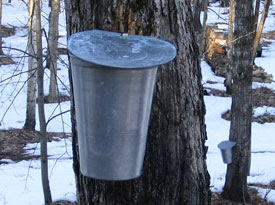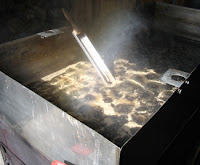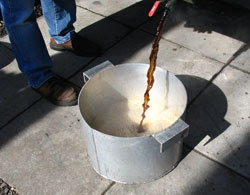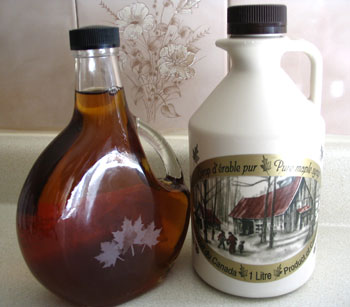A visit to my parent's home in Muskoka this past weekend coincided with the annual running of the maple sap, the short period when temperatures climb above freezing during the day and fall back below again at night that heralds every year the end of the long, cold and dreary Muskoka winter. As a child, the beginning of the Muskoka spring was a special time when my brother and I put on our winter boots and tramped about helping our folks to gather the clear sap from the hard sugar maples scattered among the beeches, cherries, oaks, birches and hemlocks of their hilly 95-acre wooded property. Turning the bountiful sap into pure delicious home-made maple syrup was an annual treat! It's been a thirty year tradition in my family, and although I've missed out on the occasion for many years now since I moved to London, I was fortunate to once again help with the syrup … even if I mostly just stood around taking photographs, enjoying the tantalizing aroma of boiling sap, and asking questions so that I could share the process and experience with my readers.
Pure maple syrup isn't just a tasty way to dress up pancakes and ice cream; it's a far healthier alternative than refined sweeteners like sugar and corn syrup. It takes about forty gallons of maple sap to make just one gallon of syrup, so the syrup is in effect concentrated tree nutrients — calcium, potassium, phosphorus, manganese, magnesium and even iron, as well as trace amounts of B vitamins and essential amino acids. In fact, 1/4 cup of pure syrup has more calcium than the same amount of milk and more potassium than a banana. And all of these nutrients remain in the syrup during the boiling, concentrating and filtering stages, so here's a sweet that shouldn't make you feel guilty.
The sap
As soon as the days start to climb above freezing temperatures, usually around mid- to late-March, my dad goes about drilling 2 to 2 1/2 inch holes in good well-grown hard maple trees that are at least 10 inches in diameter. These days he taps about sixty trees not too far away from the syrup shack. When my brother and I were little, he'd tap over 100 trees. Wherever possible, he drills the holes on the south sides of the trees where the sap runs faster, although the holes must be drilled at least 6 inches away from the scars of previous years' drilling. After drilling, a stainless steel spout is tapped into the hole from which the sap runs into a galvanized steel pail hanging from a wire hook on the spout. The best sap runs occur when the temperature is about -5°C at night followed by a quick warming in the morning to about plus 5 or 6°C. The sap won't run when it's either too cold or too warm, but every season yields at least a couple of weeks worth of good days. On an ideal day, one tree might produce almost a gallon of sap, and over the course of the syrup season, usually about three weeks, an average maple tree will give about 10 or 12 gallons from each tap hole.
To make quality maple syrup, the sap must be fresh and cold, which means it must be gathered and boiled in the same sugarbush. If the sap is allowed to collect too long before boiling, it will sour and spoil. As soon as there's enough sap in the buckets, the pails are collected and carried to the syrup shack built by my dad, and collected into large containers. After skimming off any dirt, twigs or insects that surface at the top, the maple sap is ready for boiling.
The boil
It takes a lot of time and fuel to boil a large volume of sap into concentrated syrup, and so the process is usually started in the morning. Like most traditional sugarmakers, our family burns wood cut from our own woodlot to boil the sap and evaporate the water content. A large, shallow 40-gallon steel pan sits on top of a wide iron-cast woodstove, both made by my grandfather. Once the fire is going, the raw sap is poured into the pan and the rest of the process is pretty much simply, as my father says, "boil, boil and boil." The smell of the boiling sap is heavenly, and I can stand for minutes with my head in the steam just inhaling the delicious vapors.
As the liquid in the pan goes down through evaporation, more raw sap can be added throughout the day. One good day's pan-full can take twenty-four hours to boil away into syrup, and wood is added to the fire occasionally to maintain the boil. More dirt comes to the top in the foam, and the foam is skimmed off once in a while. A small forty-gallon batch won't be done until the evening, but most batches are just allowed to sit covered up overnight before firing up the stove again in the morning and finishing off the maple syrup.
The syrup
When the sap has been reduced and starts to thicken, a thermometer is added to the mix. As the sap concentrates, the boiling point rises. Finished syrup boils at 7° Fahrenheit above the boiling point of water, and as the temperature of the boiling sap approaches this point, the boiling is carefully watched to prevent burning and overheating. The maple syrup is done when the temperature reaches 218° Fahrenheit — but that's the temperature for our sugarbush, as the boiling point varies with altitude and barometric pressure, so sugarmakers should always check the boiling point of water when they're making syrup and add 7° to find out when their syrup is done.
As soon as the boiling point has been reached, the maple syrup is drained off into large pails through filters made of felt to remove any last suspended particles and to improve the appearance of the syrup. After filtering, we bring the syrup into the house to cool down just a little. The maple syrup is bottled while still warm.
 Print this post
Print this postI just brought some home with me, and I can't wait to try it again. Commercial syrups simply don't compare with the real thing — they're usually made with corn syrup, artificial flavors and additives, and only sometimes with a little real maple syrup. I think I'll whip up some of my famous oatmeal apple pancakes this weekend and pour on some fresh real maple syrup. I'll make sure to pass on the recipe.









10 comments:
That is so friggin' cool! Thanks for the post
Maple syrop in the spring!
What a treat......
BTW - Muskoka district is not Northern ON.
Maybe north of the centre of the universe but Northern Ontario ..... nope!
Amazing. This is something I want to do some day.
A country girl eh? Your full of surprises.
My mom's side of the family owns a sugarbush about a half hour from my house and I've never taken my kids there at this time of year?? I'll have to change that. I like to put homemade maple syrup on my vanilla ice cream.
As I live in Muskoka, it would be cool to maybe visit and show the girls around.
My folks live about 20 minutes outside of Huntsville. My dad is always happy to show people around. The syrup season is nearing an end I think, though the sap might continue to run for another week or so. Just depends on the weather.
Perhaps I'll get to meet you and your girls on one of my visits home.
Next year.
Ah, great post, Lisa - reminded me of a few springs when I was a child, and had immigrated to Canada from Northern Ireland.
We lived in what was back then, a rural area north of Toronto, on a farm - and our Mennonite neighbours would make maple syrup.
I was free to run around, enjoying the whole thing, "stealing" samples, being given maple sugar candy, and of course, the wonderful smells.
Back then, my closest neighbour did all of their boiling outdoors, over a large bonfire. The sap would be in a massive cast iron pot, supported on two sides and also hung from a stand, directly over the fire.
Great memories!
Your recipes are yummy, but none made me rush downstairs to prepare them so quickly as your words about maple syrup.
I was immediately compelled to grab a couple home made but frozen waffles to warm them, then put a generous splash of warmed maple syrup on them.
That craving satisfied, I thought I had better say thanks for your words that whet my appetite. Keep up the good work Lisa, and thank your dad for his work in bringing the world genuine maple syrup (and for bringing it you too).
James
I lived in Quebec in the '70s where I made syrup. We gathered with a team of horses. Which would probably disqualify it as vegan, but we were not practicing vegans at the time. We also raised goats and used to combine our yogurt and maple syrup. T'was wicked good. Later we lived in VT and used pipeline and gravity to collect (and a few hundred buckets) so no animals were burdened. I like your site thanks.
Post a Comment